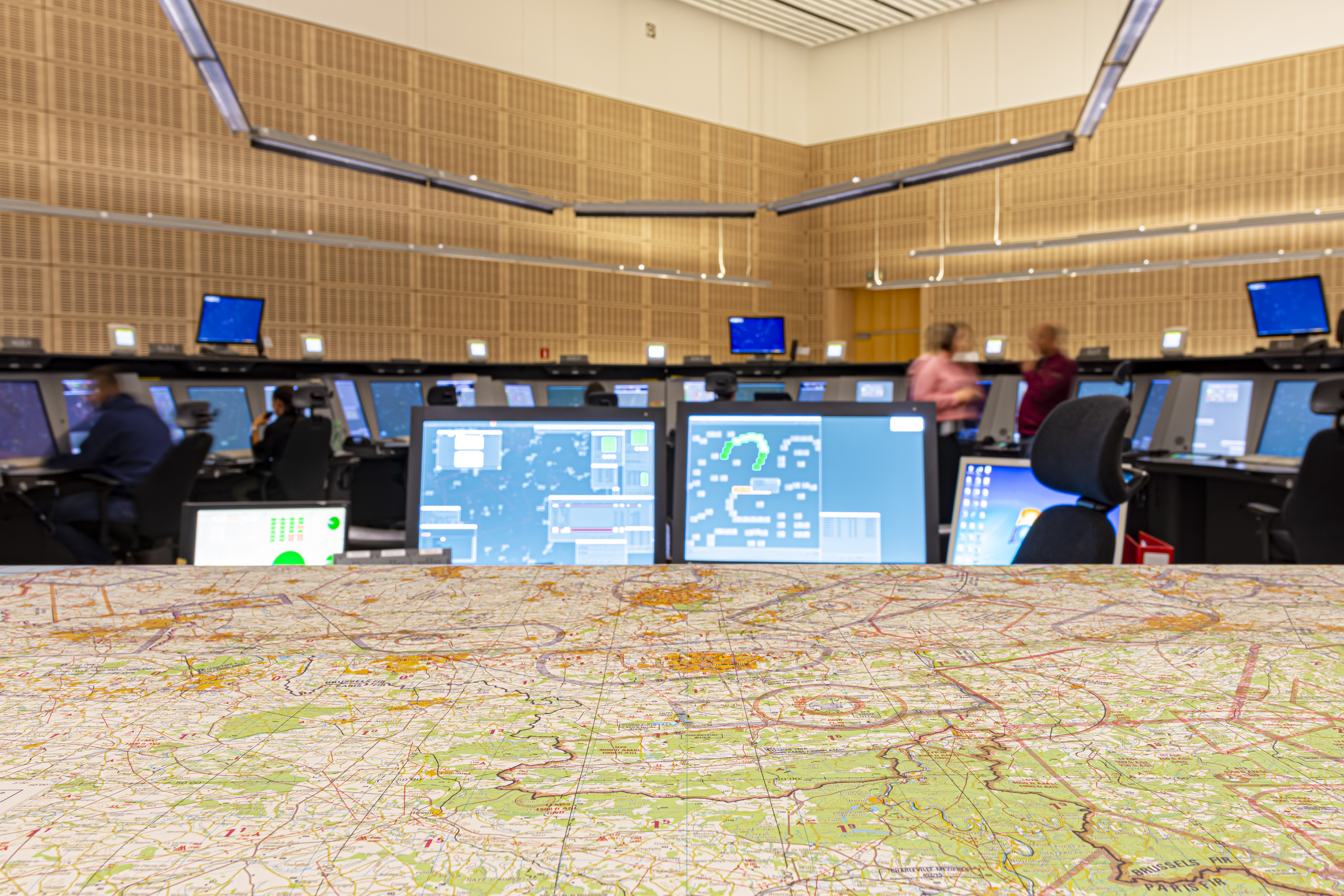A world built on innovation
Airspace is changing rapidly. In the coming years, new aircraft, some unmanned, will be crisscrossing the sky even in urban environments. Air traffic control will be carried out remotely from digital control towers. New technologies will be implemented to ensure the efficiency and safety of this new reality for air traffic, while reducing its impact on the environment. skeyes continues to invest and cooperate with its partners and take centre stage in innovation projects that will shape the new world of aviation.

Drones and U-space: a new world for air transport
Operating in very varied environments - particularly urban environments - depending on their use or mission, drones represent a very buoyant sector from an economic point of view. It is also very promising for other uses, particularly medical, because they enable very rapid transportation that is not dependent on road traffic, which is often heavy.
Inspection by drone
skeyes regularly performs flights for the calibration of navigation instruments at airports, such as Instrument Landing Systems (ILS). These inspections are carried out using small manned aircraft. In 2021, skeyes equipped itself with a drone specially designed to perform these calibrations. In 2022, flight and coordination procedures with the relevant control units were established, reducing the impact on airport capacity as well as costs, by spacing out mandatory surveillance operations carried out using specialised manned aircraft.
drone flights were introduced via the Drone Service Application (DSA) in 2022. These applications concerned drone flights in the CTRs managed by skeyes.
skeyes has been appointed Common Information Service Provider (CISP) for Belgium. The CISP is in charge of providing essential operational data to the various U-space players.
increase in these applications compared to 2021.
of complex missions, referred to as SPECIFIC.
of missions of less complexity, referred to as OPEN.
Digital towers: test & training platform installed
skeyes aims to gradually equip all Belgian airports with digital control towers in order to increase the efficiency, flexibility and resilience of air navigation services.
After the selection of the supplier - Saab Digital Air Traffic Solutions - and the agreement concluded in 2021 with SOWAER regarding the installation of the first digital towers in Namur for managing airport traffic in Liege and Charleroi, skeyes continued the project in 2022 by setting up the test and training platform on its Steenokkerzeel site.
An important milestone in the project, the test and training platform will be used to start developments in terms of ergonomics on working positions, familiarise controllers on the basis of known traffic scenarios, anticipate operational validation scenarios, support new projects at aerodromes and provide safety cases or proofs of concept.

ATM systems: upgrades and modernisation
In 2022, skeyes launched the major Mid-Life Upgrade 2.0 project for the Eurocat system that is installed in the CANAC 2 air traffic control centre and the control towers, with the aim of modernising and preparing it for the future. In addition to the complete update of all Eurocat sub-systems and the associated new requirements to counter cyberattacks, the project also includes functional updates to meet new requirements.

Performance Based Navigation :
the future of air navigation
Performance-based Navigation (PBN) is the future of air navigation. Based on satellite technology and coupled with on-board technologies, PBN enables aircraft to follow very precise waypoints, leading to benefits for safety, cost-efficiency and the environment.
In 2022, the new PBN procedures (RNAV1 and RNP APCH) were developed and tested at Liege and Charleroi airports. Those in Brussels, Antwerp and Ostend will follow in 2023.
In a later phase, the objective will be to make Belgian airports full PBN environments. All conventional procedures - unless they are necessary for redundancy - will then be removed.


first BVLOS flights
The 1st European flight Beyond Visual Line of Sight (BVLOS) in an urban environment was conducted as part of the SAFIR-Med project on 21 June 2022 in Antwerp.
Launched in December 2020, the SAFIR-Med project (Safe and Flexible Integration of Advanced U-Space Services Focusing on Medical Air Mobility) aims to develop solutions for the integration of safe, sustainable and socially acceptable urban air mobility for the benefit of the community by focusing on medical applications.
In 2022, with the participation of skeyes, the project consortium developed technical and procedural solutions to coordinate flights between drone operators, the U-space Service Provider (USSP) and the air navigation service provider. Real flights were thus able to be carried out safely, including flights beyond the sight of the remote pilot (Beyond Visual Line of Sight - BVLOS).
SWIM: data exchange network
The establishment of a Trust Framework was finalised in 2022 as part of the implementation of System-Wide Information Management (SWIM), which aims to use open and interoperable standards enabling the exchange of information and data between air navigation service providers and users.
Dispatcher 3: improving flight efficiency
The Dispatcher 3 project was completed in 2022. It consists of optimising pre-flight operations, such as drawing up the flight plan, using data processing software that makes it possible to estimate the variability between a flight plan and the flight actually carried out. The Dispatcher 3 project will provide very valuable tools for dispatchers, pilots and planners to improve the efficiency of flights.
Digital towers

a U-space concept for Belgium
18 partners are working together within the BURDI project to implement the U-space concept in Belgium.
In June 2022, skeyes was appointed coordinator of the BURDI project. The kick-off meeting for this EU-co-funded project took place on 4 November 2022. The ambition is to implement U-space airspace in controlled and non-controlled airspace in Belgium through the certification of skeyes as a Common Information Service Provider (CISP), of SkeyDrone as a U-space Service Provider (USSP) and the publication of this U-space airspace.
TCAST: forecasting traffic complexity
In December 2022, skeyes successfully completed the implementation of TCAST (Traffic Complexity Assessment and Simulations Tool), its local tool for assessing and simulating traffic complexity in its en-route airspace. TCAST continuously analyses and evaluates the current and expected traffic situation and anticipates the workload of air traffic controllers.
Mode-S radar:
less antenna, more efficiency
In May 2022, skeyes signed a contract for the purchase and installation of two new Mode-S radar systems that will replace the four existing antennas.


